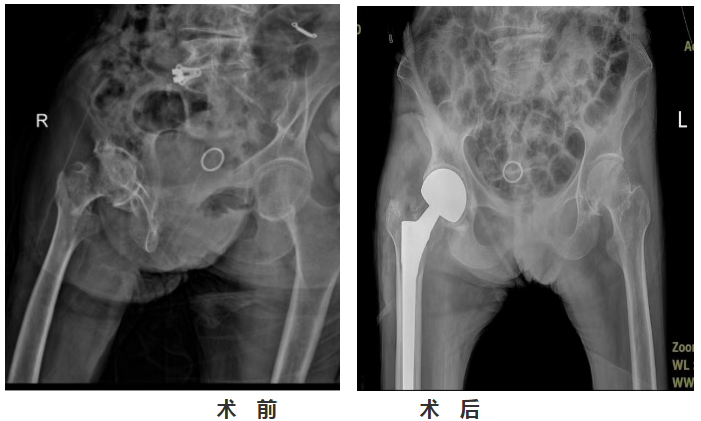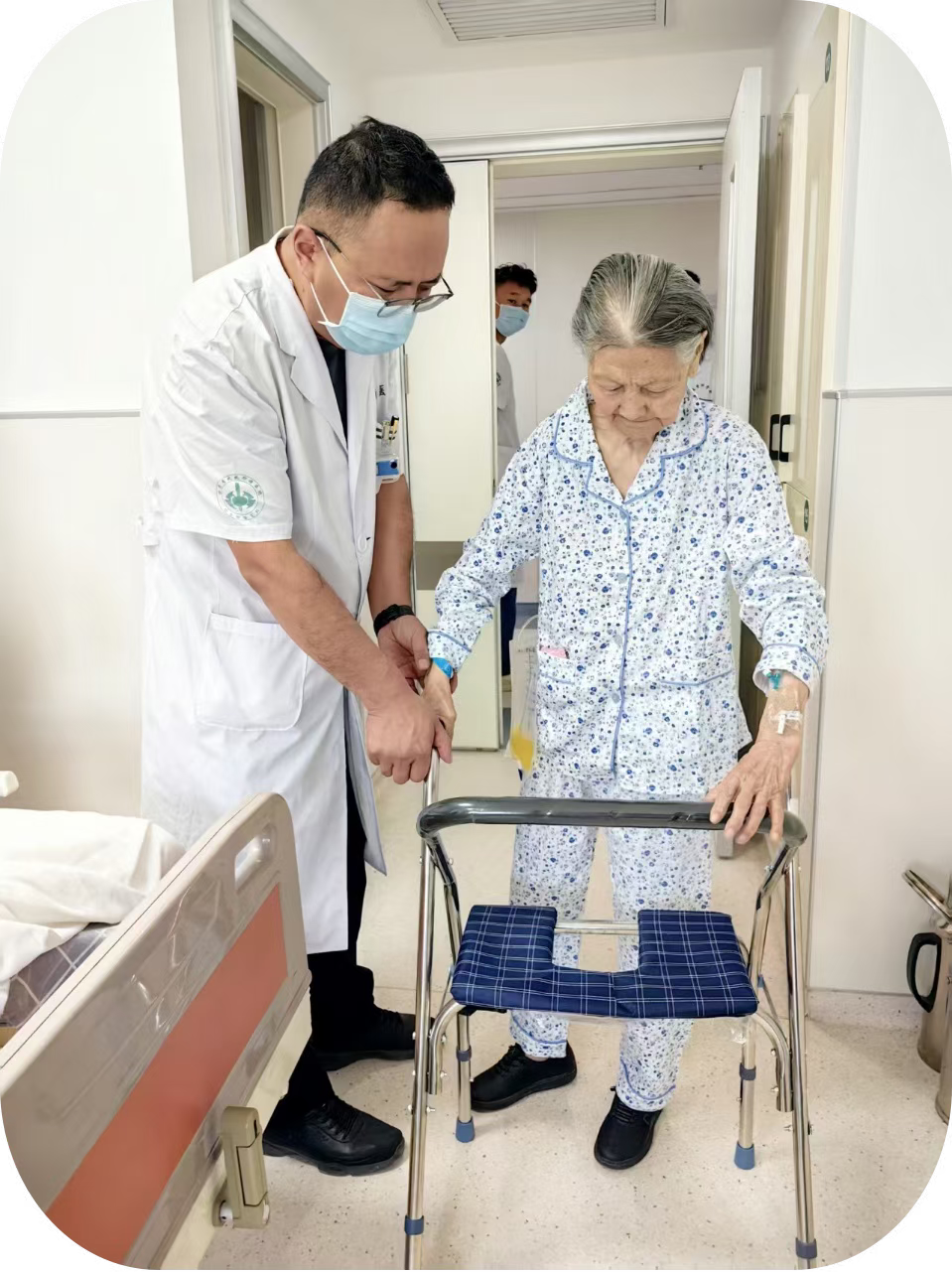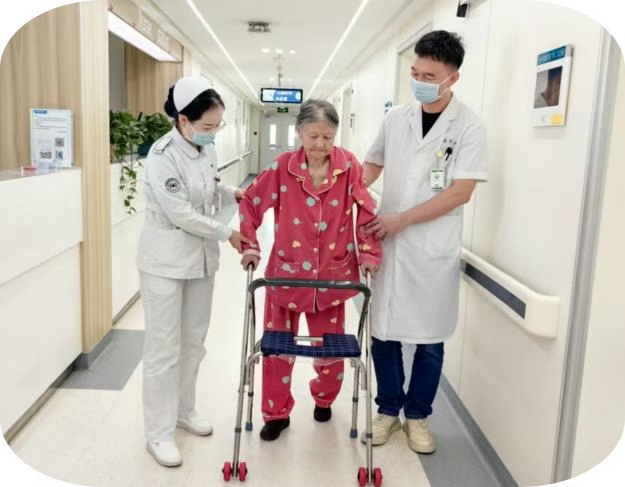Crossing the "High-Age Forbidden Zone" of Life, Nonagenarian Regains "Walking Freedom"
Crossing the "High-Age Forbidden Zone" of Life, Nonagenarian Regains "Walking Freedom"
“I really didn't expect that at my advanced age, and with such a severe fall, I could stand up on my own so quickly!" On the morning of September 26th, in the ward of the Department of Orthopedics and Rehabilitation at Wuwei Cancer Hospital, 95-year-old Grandma Fu said happily, tightly holding the hand of Director Xu Degang. The elderly lady's eyes sparkled, her smile full of relief. Witnessing the elderly lady able to walk with the aid of a walker just two days after hip replacement surgery, the family was filled with surprise and gratitude. At this moment, all the efforts of our entire team felt truly worthwhile!
Sudden Accident: 95-Year-Old Grandma Suffers "Fatal Fracture"
A week ago, Grandma Fu fell at home, experiencing severe pain in her right hip and an inability to stand. She was urgently taken to a local hospital by her family and diagnosed with a "right femoral neck fracture." Due to her advanced age, poor physical condition, and high surgical risk, the local hospital recommended transfer to a higher-level hospital, after which the patient came to our hospital. This type of fracture is known in the medical community as the "last fracture in one's life," with extremely high mortality and disability rates. Choosing conservative bed rest means confronting risks of life-threatening complications such as hypostatic pneumonia, pressure injuries, and thrombosis. Opting for surgery, however, poses a significant challenge to the patient's overall condition, anesthesia tolerance, and surgical technique.
Multidisciplinary Collaboration: "Tailor-Making" a Plan for Life
Faced with the family's anxiety and expectations, the Department of Orthopedics and Rehabilitation team acted swiftly. "As long as there is a one percent hope, we must put in one hundred percent effort" is the team's professional creed. The department immediately initiated a Multidisciplinary Team (MDT) consultation, inviting relevant specialists from Anesthesiology, Cardiology, Respiratory Medicine, Critical Care Medicine, Nutrition, Rehabilitation, and other departments to comprehensively assess Grandma Fu's physical status, anesthesia risks, and cardiopulmonary function. They meticulously deliberated over every potential risk point during the surgery and the perioperative period. The Anesthesiology department ultimately decided on epidural anesthesia, the Nutrition department formulated a perioperative nutrition plan, and the Rehabilitation department developed a perioperative rehabilitation plan.
Minimally Invasive Breakthrough: 45-Minute Conquest of the "High-Age Surgical Barrier"
For elderly patients undergoing surgery, the key lies in precise control and rapid recovery. We provided support for anesthesia and surgery through preoperative nutritional support and respiratory training; intraoperatively, we adopted minimally invasive techniques to shorten time and reduce trauma; postoperative rapid recovery – medical staff guided from quadriceps training begins, to assisting in sitting up and standing, then supporting her in taking steps on the ground, each step was steady and solid.

Accelerated Recovery: Achieving "Independent Walking" 2 Days Post-Surgery
Postoperative rapid recovery is key to the treatment. Guided by the "Enhanced Recovery After Surgery (ERAS)" concept, the nursing and medical teams worked in sync: 2 hours post-surgery, the responsible nurse instructed Grandma Fu in ankle pump exercises to effectively prevent deep vein thrombosis in the lower limbs; a multimodal analgesia plan was adopted to ensure the elderly woman was free from pain during rehabilitation training. With a customized personalized rehabilitation plan and under the meticulous care of the medical staff, by the second day after surgery, Grandma Fu was already able to walk 50 meters with a walker in the wards and corridors. The former despair was completely replaced by the joy of standing again.


Health Reminder: Preventing Falls, Protecting Elderly Health
Using this case as an example, the medical team of the Department of Orthopedics and Rehabilitation specially reminds the general public: The elderly, with declining bone quality, weakened muscle strength, and reduced balance function, are a high-risk group for falls. It is recommended to take anti-slip measures at home, keep floors dry, remove obstacles from walkways, and install handrails in locations like bathrooms and corridors. Daily, appropriate nutrition should be strengthened, ensuring adequate calcium and vitamin D intake, and engaging in moderate physical exercise to enhance muscle strength and balance ability. Once a fall occurs, especially if there is pain after landing on the hip and an inability to walk, it is essential to seek immediate medical attention. Modern medical technology can already help many elderly fracture patients regain their walking ability. Timely and scientific treatment is the key to a good prognosis.
Forging Ahead: Guarding the Dignity of Every Life
Grandma Fu's recovery is a concentrated reflection of the hospital's medical strength under the multidisciplinary collaboration model. From preoperative assessment to surgical implementation, from postoperative monitoring to rehabilitation training, every steps embodies the wisdom and sweat of the medical staff. In the future, the Department of Orthopedics and Rehabilitation at Wuwei Cancer Hospital will continue to optimize the diagnosis and treatment pathways for geriatric orthopedics, improve the "MDT + Enhanced Recovery" model, and help more elderly patients cross the "surgical forbidden zone." "Life first, caring with heart" is not only the belief of all the medical staff in the department but also their code of action – using professional skills and warm care to protect the walking freedom of every elderly person, allowing the dignity of life to shine brilliantly throughout the medical process.
Introduction to the Department of Orthopedics and Rehabilitation
The Department of Orthopedics and Rehabilitation is a key discipline in our city. It mainly diagnoses and treats diseases related to bone and soft tissue tumors, trauma, joints, and spinal surgery. The department currently has 3 chief physicians, 1 associate chief physician, 5 attending physicians, and 1 resident physician, among whom 3 are postgraduate students. The talent echelon is reasonable, and all have received specialized training. Department personnel have pursued advanced studies in nationally renowned orthopedic centers such as Beijing Jishuitan Hospital, Shanghai Changzheng Hospital, Xi'an Honghui Hospital, and Xijing Hospital, possessing strong capabilities in orthopedic diagnosis and treatment. The department features advanced facilities and has established a strong technological platform with the strong support of the hospital. It independently performs complex surgeries such as retroperitoneal tumor resection, total vertebrectomy, femoral and tibial bone tumor resection, and customized prosthesis replacement reconstruction; total hip, total knee, total elbow, and partial knee replacement surgeries are routinely performed; surgical treatments for degenerative changes of the cervical and lumbar spine are routinely carried out, with efficacy affirmed by the majority of patients. All medical staff in the department provide high-quality medical services to patients in the local area with exquisite skills and patient, attentive service.
Address: Department of Orthopedics and Rehabilitation, 9th Floor, Inpatient Building, Wuwei Cancer Hospital Central Campus.
